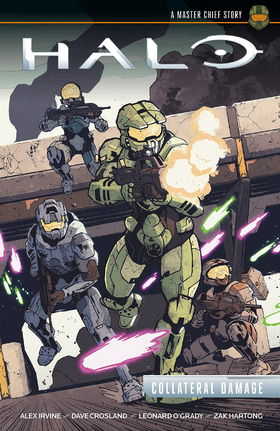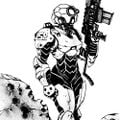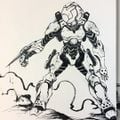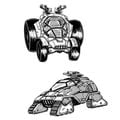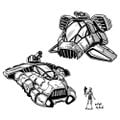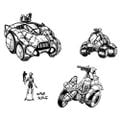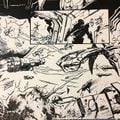Halo: Collateral Damage
From Halopedia, the Halo wiki
Halo Collateral Damage: A Master Chief Story, or simply Halo: Collateral Damage, is a three-chapter mini-series produced by Dark Horse Comics that focuses on a young teenage John-117 during some of his early days in the Human-Covenant War.[1] Collateral Damage is written by Alex Irvine, whose previous contributions include Halo: Tales from Slipspace's story Something Has Happened and Halo: Rise of Atriox Issue 4. The comic miniseries also shares narrative connections to the other works in the A Master Chief Story series, primarily the novel Halo: Silent Storm from author Troy Denning.[2]
Official Summary[edit]
| “ | The Master Chief and Blue Team are deployed by the UNSC to Alpha Corvi II, a precarious human colony world, seeking to halt the Covenant's efforts to uncover something hidden below the planet's surface.
Before they were legends in the Halo universe, they were soldiers on the front lines. Alpha Corvi II is under a full-scale attack by humanity's newfound enemy, the Covenant. While most of the UNSC's forces have been ordered to defend the colony's primary city, a Covenant strike team has infiltrated a small mining settlement. With resources limited, the UNSC sends the Spartans--the Master Chief and Blue Team--to neutralize the alien threat and discover what they're after. The Spartan strike team quickly finds out that they will have to rely on each other and a small cadre of human rebels in order to survive and complete their mission. Writer Alex Irvine (Halo: Rise of Atriox, Halo: Tales From Slipspace) and artist Dave Crosland (Halo: Tales From Slipspace) lead us on a thrilling mission from the early days of the three-decade long Covenant War.[3] |
” |
Plot synopsis[edit]
Halo: Collateral Damage takes places on December 3, 2525, and follows the Master Chief and Blue Team as they are deployed by the UNSC to an unstable colony world. Their mission: to terminate the Covenant's efforts to uncover something ancient and powerful beneath the planet's surface. However, as the mission takes a turn for the unexpected, the Spartan-II strike team realizes that the stakes of their mission are higher than they imagined, and they'll have to rely on each other and a small group of human rebels to survive.[1]
Issues[edit]
| Issue | Release | Writer(s) | Artist(s) | Official summary |
|---|---|---|---|---|
 Issue #1 |
June 6, 2018 | Alex Irvine |
|
The Master Chief and Blue Team are deployed by the UNSC to Alpha Corvi II, a precarious human colony world, seeking to halt the Covenant’s efforts to uncover something hidden below the planet’s surface. The Spartan strike team quickly finds out that they will have to rely on each other and a small cadre of human rebels in order to survive and complete their mission.[4] |
 Issue #2 |
July 4, 2018 | The Master Chief and Blue Team split from their rebel allies while facing off against Covenant forces in the depths of a mine on Alpha Corvi II, a precarious human colony. The rebel forces have to cut off Covenant reinforcements, but in doing so, their plan may condemn Blue Team to certain destruction.[5] | ||
 Issue #3 |
August 15, 2018 | Trapped by a cave-in and surrounded by the Covenant, Blue Team must work together with Insurrectionist rebels to fight off the alien invaders. Outnumbered and outgunned, the Spartans must do whatever it takes to complete their mission and keep a Forerunner artifact out of Covenant hands.[6] |
Appearances[edit]
Trivia[edit]
At some point during development, Collateral Damage was named Halo: Forefront.[7]
Gallery[edit]
Sources[edit]
- ^ a b Halo Waypoint: Halo Collateral Damage: A Master Chief Story
- ^ Halo Waypoint: Halo: Silent Storm - First Look
- ^ Amazon: Halo: Collateral Damage Hardcover
- ^ Newsarama: Dark Horse June 2018 solicitations
- ^ Previews World: Halo: Collateral Damage Issue 2
- ^ Bleeding Cool: Dark Horse Launches Frozen, Predator, Terminator, Seeds, Incognegro, Beasts Of Burden, Conspiracy Of Ravens in August 2018 Solicitations
- ^ David Crosland's online store - Artwork named Halo: Forefront (Archive.org)
| |||||||||||||||||
